Analysis of Precipitation Variation Characteristics in Typical Chinese Regions Within the Indian Ocean and Pacific Monsoon Convergence Zone
Abstract
1. Introduction
2. Study Area and Data
2.1. Study Area
2.2. Data Sources
3. Methods
3.1. Trend Analysis of Precipitation Time Series
3.1.1. Linear Regression Method
3.1.2. Mann–Kendall Trend Test
3.1.3. Moving Average Method
3.1.4. Cumulative Anomaly Method
3.2. Mann–Kendall–Sneyers Test (MKS)
3.3. Wavelet Analysis
3.4. R/S Analysis
3.5. Kriging Interpolation Method
3.6. Definition and Calculation of EPIs
4. Results
4.1. Temporal Variation Patterns of Precipitation
4.1.1. Trend Analysis
4.1.2. Mann–Kendall–Sneyers Test (MKS) Analysis
4.1.3. Periodicity Analysis
4.1.4. Future Trend Analysis
4.1.5. Temporal Variation Characteristics of EP
4.2. Spatial Variation Patterns of Precipitation
4.2.1. Spatial Distribution Characteristics of Annual Precipitation
4.2.2. Spatial Variation Characteristics of EPIs
5. Discussion
- (1)
- From the overall characteristics of precipitation in the study area, the precipitation in the past 45 years has shown an overall upward trend, and the climate tendency rate is 9 mm/10 a, reflecting the increasing trend in precipitation under the background of global climate change and monsoon convergence. The annual precipitation fluctuates greatly from 1979 to 2023, and the interannual variation is more significant. Since the study area is an important tributary of the MLRYR, the increasing trend in annual precipitation will lead to an increase in annual precipitation in the MLRYR, which is consistent with the research results [61]. According to the analysis of moving averages and cumulative anomalies, annual precipitation exhibits an alternating pattern of “dry–wet–dry–wet” over time. The spatial distribution of annual precipitation shows a tendency for more precipitation in the northeast and Jingzhou and Tongtong in the south, and less in the west, which is related to its special topography and climatic zones [62].
- (2)
- In terms of the decadal characteristics of precipitation in the study area, annual precipitation exhibits significant periodic variations, particularly at the primary timescales of 9 and 28 years. Within these cycles, precipitation has undergone pronounced wet and dry fluctuations, with the start and end points of these cycles showing strong intrinsic regularity.
- (3)
- Regarding the temporal variations of EPIs in the study area, all indices exhibited an upward trend during the period 1979–2023, except for CDD and CWD. These findings are consistent with the results of Zou et al. [63] for the middle and lower reaches of the Yangtze River. Because the movement of the southwest climate front is consistent with the direction of Wuling Mountain, the area where the north and south climate fronts intersect overlaps with the distribution of Wuling Mountain, and the summer monsoon index shows significant control of and influence on the EP in the study area, resulting in significant increases in the intensity and duration of some EP events, especially in the frequency of heavy precipitation and extremely heavy precipitation [64]. Most EPIs underwent abrupt changes around 1990. CWD exhibited a significant decreasing trend, while R10, R20, RX1, RX5, R95P, and R99P showed non-significant increasing trends. Most EPIs exhibit periodic oscillations, with the oscillations of the nine indices tending to occur at low-frequency scales (around 28 years). This implies that from 1979 to 2023, the frequency of “increase–decrease” changes in each EPI has been relatively low. Studies have shown that [65] during 1970–2018, each EPI in the MLRYR exhibited frequent “increase–decrease” changes, which significantly differ from the findings of this research, which may be due to the inconsistency of the results caused by regional and local differences.
- (4)
- The spatial variations in EPIs in the study area indicate that indices such as R10, R20, RX1, and RX5 are more concentrated in the northeastern and southern regions, exhibiting stronger EP characteristics, while the western region remains relatively stable. EP events in the study area showed an opposite trend, exacerbating the uneven distribution of precipitation [66]. This phenomenon may be attributed to the complex interactions among geographical features, urbanization, and the climate system [67].
6. Conclusions
- (1)
- The annual precipitation for the study area exhibits an overall upward trend, with a climatic tendency rate of 9 mm/10 a. Moreover, wetter and drier years alternate, exhibiting significant periodic variations. The Mann–Kendall abrupt change detection reveals that the change in annual precipitation is not statistically significant. Although trend changes occurred during specific periods, the overall variation did not reach statistical significance.
- (2)
- Wavelet analysis reveals that the dominant cycles of annual precipitation are 28, 9, and 4 years, with distinct precipitation patterns observed at different timescales. Wet and dry periods at larger timescales influence variations at shorter timescales. Simultaneously, the R/S analysis results indicate that future precipitation trends will continue to rise, demonstrating strong long-term memory.
- (3)
- The EPIs in the study area exhibit an overall upward trend, particularly the maximum 1 day precipitation (RX1), maximum 5 day precipitation (RX5), heavy precipitation (R95P), and extreme heavy precipitation (R99P), all of which demonstrate increasing trends. The extreme drought index (CDD) and the consecutive wet days index (CWD) exhibit decreasing trends, indicating a reduction in the frequency of drought events and an increase in the occurrence of extreme heavy precipitation events.
- (4)
- Spatial distribution analysis reveals significant spatial heterogeneity in precipitation across the study area, with higher precipitation amounts in the northeastern part and the southern regions of Jingzhou and Tongdao, while lower amounts are observed in the western region. The spatial distribution of EP events also exhibits a similar pattern, with greater precipitation intensity in the northeastern and southern regions, whereas the western region experiences relatively lower intensity.
Author Contributions
Funding
Data Availability Statement
Conflicts of Interest
References
- Brunsell, N.A. A multiscale information theory approach to assess spatial–temporal variability of daily precipitation. J. Hydrol. 2010, 385, 165–172. [Google Scholar] [CrossRef]
- Zhang, A.; Zhao, X. Changes of precipitation pattern in China: 1961–2010. Theor. Appl. Climatol. 2022, 148, 1005–1019. [Google Scholar] [CrossRef]
- Kumar, A.; Singh, O. Unraveling the variability and geoclimatic drivers of daily precipitation concentration over a Western Himalayan Province of India. Environ. Monit. Assess. 2025, 197, 20. [Google Scholar] [CrossRef] [PubMed]
- Qin, D.H. Climate change science and sustainable development. Prog. Geogr. 2014, 33, 874–883. [Google Scholar]
- Chen, X.; Wang, L.; Niu, Z.; Zhang, M.; Li, J. The effects of projected climate change and extreme climate on maize and rice in the Yangtze River Basin, China. Agric. For. Meteorol. 2020, 282, 107867. [Google Scholar] [CrossRef]
- Li, J.Q.; Chen, S.Y. An analysis of precipitation spatiotemporal characteristics in Xijiang River Basin based on ESMD. China Rural. Water Hydropower 2021, 6, 61–68. [Google Scholar]
- Li, Z.; Li, X.; Wang, Y.; Quiring, S.M. Impact of climate change on precipitation patterns in Houston, Texas, USA. Anthropocene 2019, 25, 100193. [Google Scholar] [CrossRef]
- IPCC. Climate Change 2021: The Physical Science Basis. In Contribution of Working Group I to the Sixth Assessment Report of the Intergovernmental Panel on Climate Change; Cambridge University Press: Cambridge, UK; New York, NY, USA, 2023; pp. 423–552. [Google Scholar]
- Hu, X.H.; Zuo, D.P. Variation analysis on the characteristics of stormflood in Yuehe River basin, Shaannan mountain area. China Flood Drought Manag. 2022, 32, 82–88. [Google Scholar]
- Zhang, W.; Zhou, T. Significant increases in extreme precipitation and the associations with global warming over the global land monsoon regions. J. Clim. 2019, 32, 8465–8488. [Google Scholar] [CrossRef]
- Greve, P.; Orlowsky, B.; Mueller, B.; Sheffield, J.; Reichstein, M.; Seneviratne, S.I. Global assessment of trends in wetting and drying over land. Nat. Geosci. 2014, 7, 716–721. [Google Scholar] [CrossRef]
- Donat, M.G.; Lowry, A.L.; Alexander, L.V.; O’Gorman, P.A.; Maher, N. More extreme precipitation in the world’s dry and wet regions. Nat. Clim. Change 2016, 6, 508–513. [Google Scholar] [CrossRef]
- Karl, T.R.; Knight, R.W. Secular Trends of Precipitation Amount, Frequency, and Intensity in the United States. Bull. Am. Meteorol. Soc. 1998, 79, 231–242. [Google Scholar] [CrossRef]
- Zhang, X.; Vincent, L.A.; Hogg, W.D.; Niitsoo, A. Temperature and precipitation trends in Canada during the 20th century. Atmos. Ocean. 2000, 38, 395–429. [Google Scholar] [CrossRef]
- Cotterill, D.; Stott, P.; Christidis, N.; Kendon, E. Increase in the frequency of extreme daily precipitation in the United Kingdom in autumn. Weather. Clim. Extrem. 2021, 33, 100340. [Google Scholar] [CrossRef]
- Romero, R.; Guijarro, J.A.; Ramis, C.; Alonso, S. A 30-year (1964–1993) daily rainfall data base for the Spanish Mediterranean regions: First exploratory study. Int. J. Climatol. 1998, 18, 541–560. [Google Scholar] [CrossRef]
- Cruz, F.T.; Narisma, G.T.; Villafuerte, M.Q., II; Chua, K.C.; Olaguera, L.M. A climatological analysis of the southwest monsoon rainfall in the Philippines. Atmos. Res. 2013, 122, 609–616. [Google Scholar] [CrossRef]
- Li, F.; Zhang, M.J.; Li, X.F.; Wang, B.L.; Wang, S.J.; Wang, Q. Variation characteristics of different-level precipitation in Ningxia of Southwest China in 1962–2011. Chin. J. Ecol. 2013, 32, 2154. [Google Scholar]
- Wang, X.L.; Zhai, P.M. Changes in in China’s precipitation in various categories during 1957~2004. J. Trop. Meteorol. 2008, 24, 459–466. [Google Scholar]
- Li, Q.; Peng, J.; Shen, Y. Development of China homogenized monthly precipitation dataset during 1900–2009. J. Geogr. Sci. 2012, 22, 579–593. [Google Scholar] [CrossRef]
- Ren, G.Y.; Ren, Y.Y.; Zhan, Y.J.; Sun, X.B.; Liu, Y.J.; Chen, Y.; Wang, T. Spatial and temporal patterns of precipitation variability over mainland China: II: Recent trends. Adv. Water Sci. 2015, 26, 451–465. [Google Scholar]
- Cai, Y.Q.; Li, W.H.; Yu, X.Z.; Li, Q.J. Temporal and Spatial Evolution of Precipitation in the Headwaters of the Yangtze River. J. Yangtze River Sci. Res. Inst. 2022, 39, 28–35. [Google Scholar]
- Zhang, J.P.; Zhang, H. Spatio-temporal variation characteristics of precipitation in the Yellow River Basin. China Rural. Water Hydropower 2022, 3, 60–68. [Google Scholar]
- Sun, J.; Ao, J. Changes in precipitation and extreme precipitation in a warming environment in China. Chin. Sci. Bull. 2013, 58, 1395–1401. [Google Scholar] [CrossRef]
- Han, J.; Zhang, R.; Guo, B.; Han, B.; Xu, T.; Guo, Q. Long-Term Variation Patterns of Precipitations Driven by Climate Change in China from 1901 to 2022. Sustainability 2024, 16, 7283. [Google Scholar] [CrossRef]
- Lu, S.; Bai, X.; Zhang, X.; Li, W.; Tang, Y. The impact of climate change on the sustainable development of regional economy. J. Clean. Prod. 2019, 233, 1387–1395. [Google Scholar] [CrossRef]
- Kalogiannidis, S.; Kalfas, D.; Papaevangelou, O.; Chatzitheodoridis, F.; Katsetsiadou, K.; Lekkas, E. Integration of Climate Change Strategies into Policy and Planning for Regional Development: A Case Study of Greece. Land 2024, 13, 268. [Google Scholar] [CrossRef]
- Lv, X.D. Climate change has serious implications for the economic and social development of the country. Impact Sci. Soc. 2010, 1, 41–45. [Google Scholar]
- Wu, S.H. Research progress in climate change impact, risk, and adaptation: An interpretation of Part 2 of China’s Fourth National Assessment Report on Climate Change. China Popul. Resour. Environ. 2023, 33, 80–86. [Google Scholar]
- Dong, S.C.; Tao, S.; Yang, W.Z.; Li, Z.H.; Li, Y. The impacts of climate change on urban agglomeration in central and westernregion of China. J. Arid. Land. Res. Environ. 2011, 25, 72–76. [Google Scholar]
- Zhang, X.N.; Luo, J.; Chen, L.; Li, H. Zoning of Chinese flood hazard risk. J. Hydraul. Eng. 2000, 3, 3–9. [Google Scholar]
- Jiang, T.; Shi, Y.F. Global climatic waring, the Yangtze floods and potential loss. Adv. Earth Sci. 2003, 18, 277–284. [Google Scholar]
- Chen, H.S.; Fan, S.D.; Zhang, H.X. Seasonal Differences of Variation Characteristics of Extreme Precipitation Events over China in the Last 50 Years. Trans. Atmo Sci. 2009, 32, 744–751. [Google Scholar]
- Gao, T.; Xie, L.A. Study on progress of the trends and physical causes of extreme precipitation in China during the last 50 years. Adv. Earth Sci. 2014, 29, 577–589. [Google Scholar]
- Gao, J.; Li, H.H.; Yao, P.; He, D.M.; Nian, A.B. Study on the water vapor convergence area and its spatial differentiation between the Indian Ocean and the Pacific Ocean in summer in the Northern Hemisphere. Progr. Nat. Sci. 2009, 19, 302–309. [Google Scholar]
- Li, X.J.; Zhu, B.Q. Interaction Between the Westerlies and Asian Monsoons in the Middle Latitudes of China: Review and Prospect. Atmosphere 2024, 15, 274. [Google Scholar] [CrossRef]
- Lin, Y.; Zhao, C. Trends of precipitation of different intensity in China. Acta Sci. Nat. Univ. Pekin. 2009, 45, 995–1002. [Google Scholar]
- Yang, X.L.; Ding, W.K.; Guo, L.M. Analysis on the basic characteristics of precipitation in the East Hexi Corridor. Arid. Zone Res. 2010, 27, 663–668. [Google Scholar]
- Xu, M.; Tan, Y.; Shi, C.; Xing, Y.; Shang, M.; Wu, J.; Yang, Y.; Du, J.; Bai, L. Spatiotemporal Patterns of Typhoon-Induced Extreme Precipitation in Hainan Island, China, 2000–2020, Using Satellite-Derived Precipitation Data. Atmosphere 2024, 15, 891. [Google Scholar] [CrossRef]
- Wang, L.J.; Zhang, X.N.; Fang, Y.H.; Xia, D.Z. Applicability Assessment of China Meteorological Forcing Dataset in Upper Yangtze River Basin. Water Power 2017, 43, 18–22. [Google Scholar]
- Huang, Q.; Wang, R.M.; Xiang, J.Y.; Qin, G.H. Spatial and Temporal Applicability of Three Precipitation Products in the Yalong River Basin. J. China Hydrol. 2020, 40, 14–21. [Google Scholar]
- Ren, M.; Xu, Z.; Pang, B.; Liu, W.; Liu, J.; Du, L.; Wang, R. Assessment of satellite-derived precipitation products for the Beijing region. Remote Sens. 2018, 10, 1914. [Google Scholar] [CrossRef]
- Li, Y.; Pang, B.; Ren, M.; Shi, S.; Peng, D.; Zhu, Z.; Zuo, D. Evaluation of performance of three satellite-derived precipitation products in capturing extreme precipitation events over Beijing, China. Remote Sens. 2022, 14, 2698. [Google Scholar] [CrossRef]
- He, Q.; Yang, J.; Chen, H.; Liu, J.; Ji, Q.; Wang, Y.; Tang, F. Evaluation of extreme precipitation based on three long-term gridded products over the Qinghai-Tibet Plateau. Remote Sens. 2021, 13, 3010. [Google Scholar] [CrossRef]
- Zhang, L.; Gao, L.; Chen, J.; Zhao, L.; Zhao, J.; Qiao, Y.; Shi, J. Comprehensive evaluation of mainstream gridded precipitation datasets in the cold season across the Tibetan Plateau. J. Hydrol. Reg. Stud. 2022, 43, 101186. [Google Scholar] [CrossRef]
- Wen, T.T.; Guo, Y.X.; Dong, S.R.; Dong, Y.Z.; Lai, X.L. Assessment of CRU, ERA5, CMFD grid precipitation data for the Tibetan Plateau from 1979 to 2017. Arid. Zone Res. 2022, 39, 684–697. [Google Scholar]
- Luo, B.L.; Zhang, C.; Lin, H. Characteristics of Climatic Changes and Catastrophe of Extreme Precipitation in Hunan in Recent 40 Years. Meteorol. Mon. 2008, 34, 80–85. [Google Scholar]
- Zhang, K.; Li, X.L.; Zhang, Q.J.; Li, L.; Pei, W.X. Temporal and Spatial Variation Characteristics of Temperature and Precipitation GIS in Huaihua City During 1981–2010. Guizhou Agri. Sci. 2014, 42, 107–111. [Google Scholar]
- Pu, H.Z. Exploration and practice of mountain flood disaster prevention in Huaihua City, Hunan Province. China Flood Drought Manag. 2023, 33, 64–67. [Google Scholar]
- He, J.; Yang, K.; Tang, W.; Lu, H.; Qin, J.; Chen, Y.; Li, X. The first high-resolution meteorological forcing dataset for land process studies over China. Sci. Data 2020, 7, 25. [Google Scholar] [CrossRef]
- Yang, K.; He, J.; Tang, W.; Qin, J.; Cheng, C.C. On downward shortwave and longwave radiations over high altitude regions: Observation and modeling in the Tibetan Plateau. Agric. For. Meteorol. 2010, 150, 38–46. [Google Scholar] [CrossRef]
- Mann, H.B. Non-parametric test against trend. Econometrica 1945, 13, 245–259. [Google Scholar] [CrossRef]
- Kendall, M.G. Rank Correlation Methods; Oxford University Press: Oxford, UK, 1948. [Google Scholar]
- Kumar, V.; Jain, S.K. Trends in seasonal and annual rainfall and rainy days in Kashmir Valley in the last century. Quatern Int. 2010, 212, 64–69. [Google Scholar] [CrossRef]
- Han, G. Analysis on Climate Change of the Qinghai-Tibet Plateau in the Recent 50 Years. Master’s Thesis, Chengdu University of Technology, Chengdu, China, 2012. [Google Scholar]
- Khan, A.; Hassan, D.; Raza, S.M.M.; Amjad, M.; Mian, K. Applications of wavelet transform in climatic time series: A case study of Gilgit-Baltistan, Pakistan. Int. J. Environ. Sci. Technol. 2025. [Google Scholar] [CrossRef]
- Makarava, N.; Menz, S.; Theves, M.; Huisinga, W.; Beta, C.; Holschneider, M. Quantifying the degree of persistence in random amoeboid motion based on the Hurst exponent of fractional Brownian motion. Phys. Rev. E 2014, 90, 42703. [Google Scholar] [CrossRef]
- Karl, T.R.; Nicholls, N.; Ghazi, A. Clivar/GCOS/WMO workshop on indices and indicators for climate extremes workshop summary. Clim. Change 1999, 42, 3–7. [Google Scholar] [CrossRef]
- Wu, P.; Ding, Y.H.; Liu, Y.J. A new study of EI Nino impacts on summertime water vapor transport and rainfall in China. Acta Meteorol. Sin. 2017, 75, 371–383. [Google Scholar]
- Chang, C.P.; Zhang, Y.; Li, T. Interannual and interdecadal variations of the East Asian summer monsoon and tropical Pacific SSTs. Part II: Meridional structure of the monsoon. J. Clim. 2000, 13, 4326–4340. [Google Scholar] [CrossRef]
- Zhang, S.; Ren, G.; Zhan, Y.; Zhang, C.; Ren, Y. Extreme precipitation changes over the Yangtze River Basin in 1901–2020. Clim. Res. 2023, 90, 59–76. [Google Scholar] [CrossRef]
- Liu, N.; Jiang, W.; Huang, L.; Li, Y.; Zhang, C.; Xiao, X.; Huang, Y. Evolution of Sustainable Water Resource Utilization in Hunan Province, China. Water 2022, 14, 2477. [Google Scholar] [CrossRef]
- Zou, L.; Xia, J.; Zhang, Y. Spatial-temporal Characteristics of Extreme Precipitation in the Middle and Lower Reaches of the Yangtze River. Resour. Environ. Yangtze Basin 2021, 30, 1264–1274. [Google Scholar]
- Chen, A.; He, X.; Guan, H.; Cai, Y. Trends and periodicity of daily temperature and precipitation extremes during 1960–2013 in Hunan Province, central south China. Theor. Appl. Climatol. 2018, 132, 71–88. [Google Scholar] [CrossRef]
- Wu, S.; Hu, Z.; Wang, Z.; Cao, S.; Yang, Y.; Qu, X.; Zhao, W. Spatiotemporal variations in extreme precipitation on the middle and lower reaches of the Yangtze River Basin (1970–2018). Quatern Int. 2021, 592, 80–96. [Google Scholar] [CrossRef]
- Yang, J.; Huang, Y.; Li, G.; Li, Y. Changes of extreme precipitation in the middle and lower reaches of the Yangtze River and their correlation with atmospheric circulation. Front. Earth Sci. 2023, 11, 1162220. [Google Scholar] [CrossRef]
- Wu, L.; Ye, A.; Wang, Y.; Li, Q.; Zhan, S. Urbanization influence on changes of extreme precipitation in mainland China. Glob. Planet. Change 2025, 246, 104720. [Google Scholar] [CrossRef]
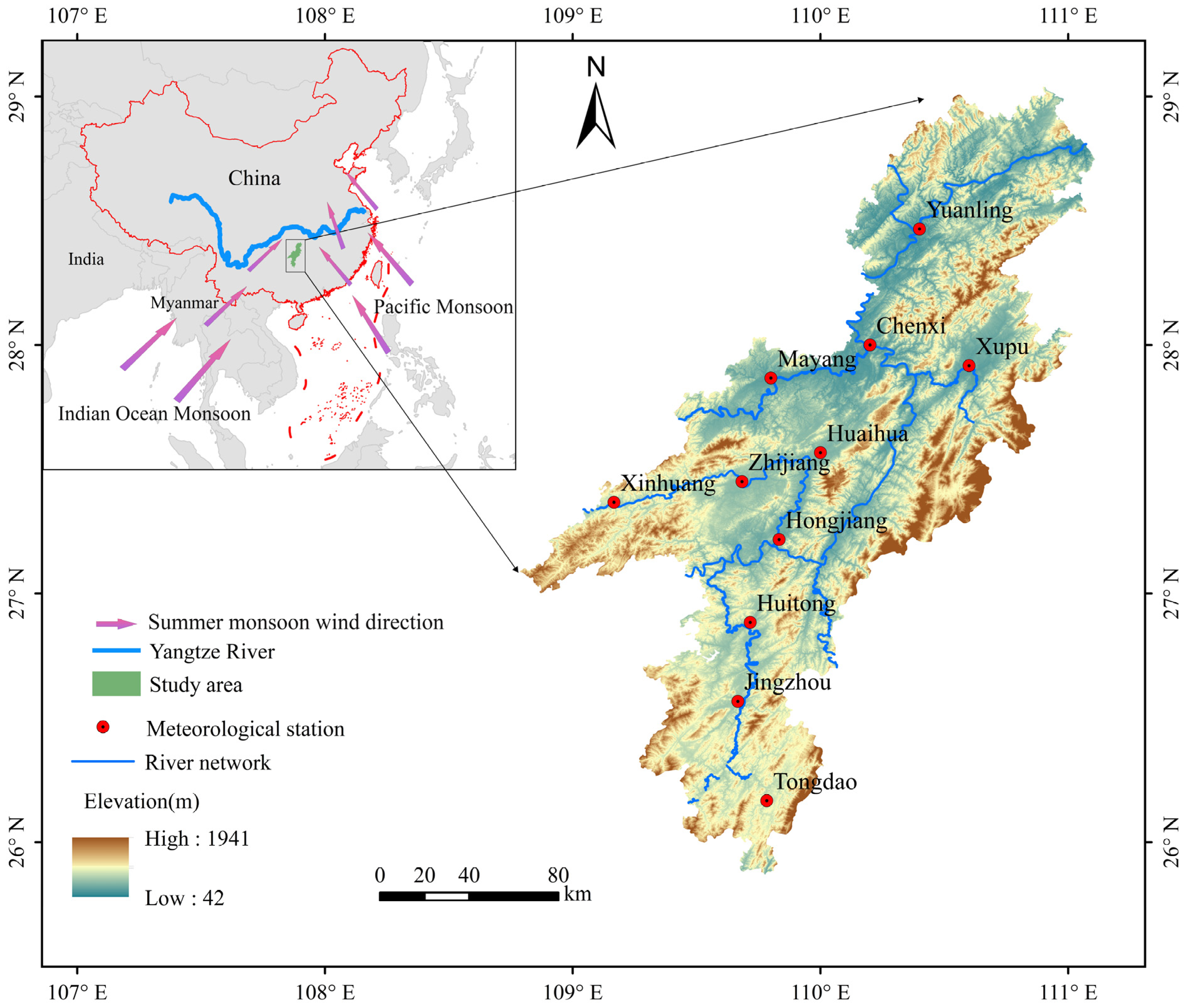
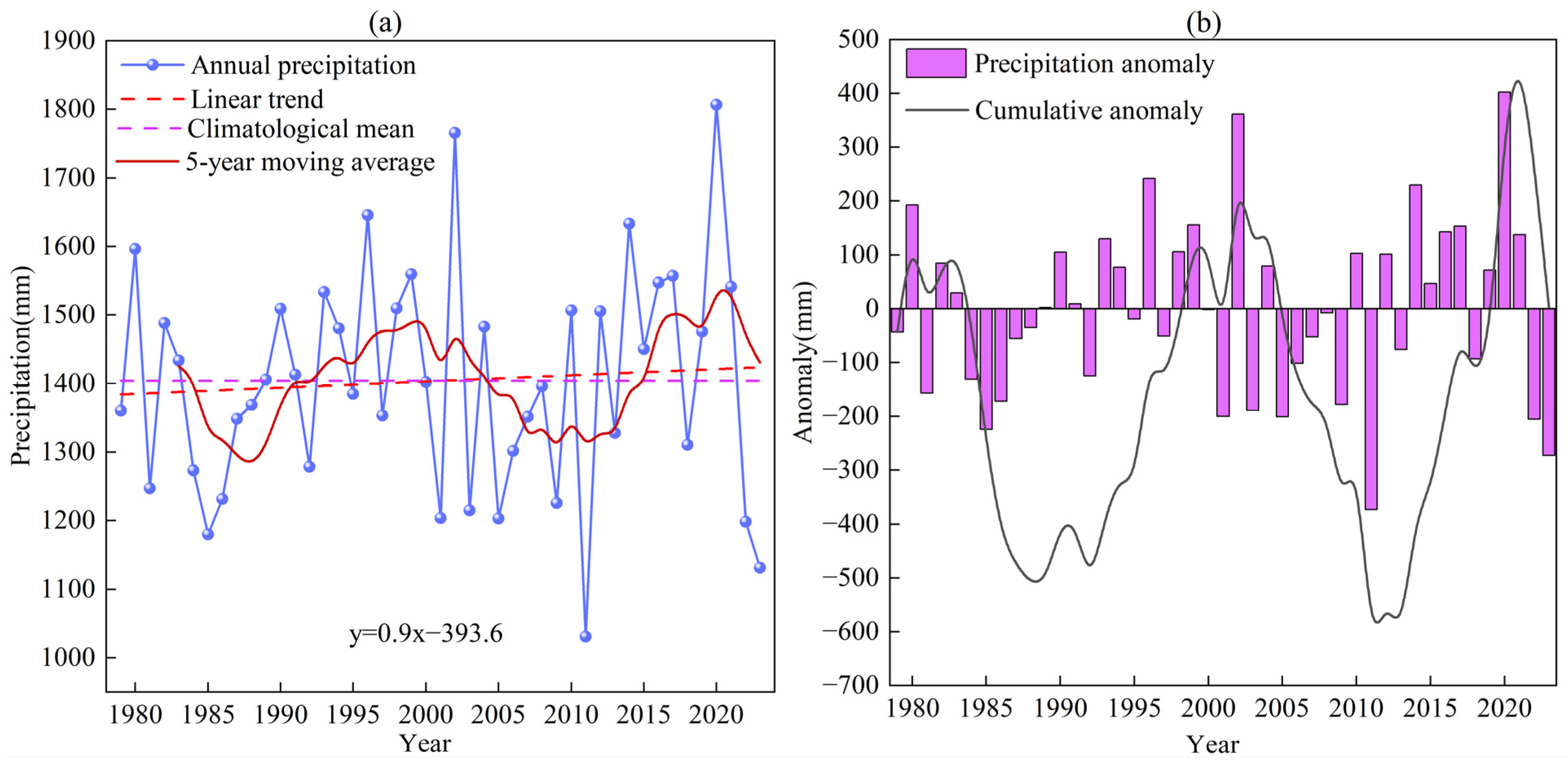
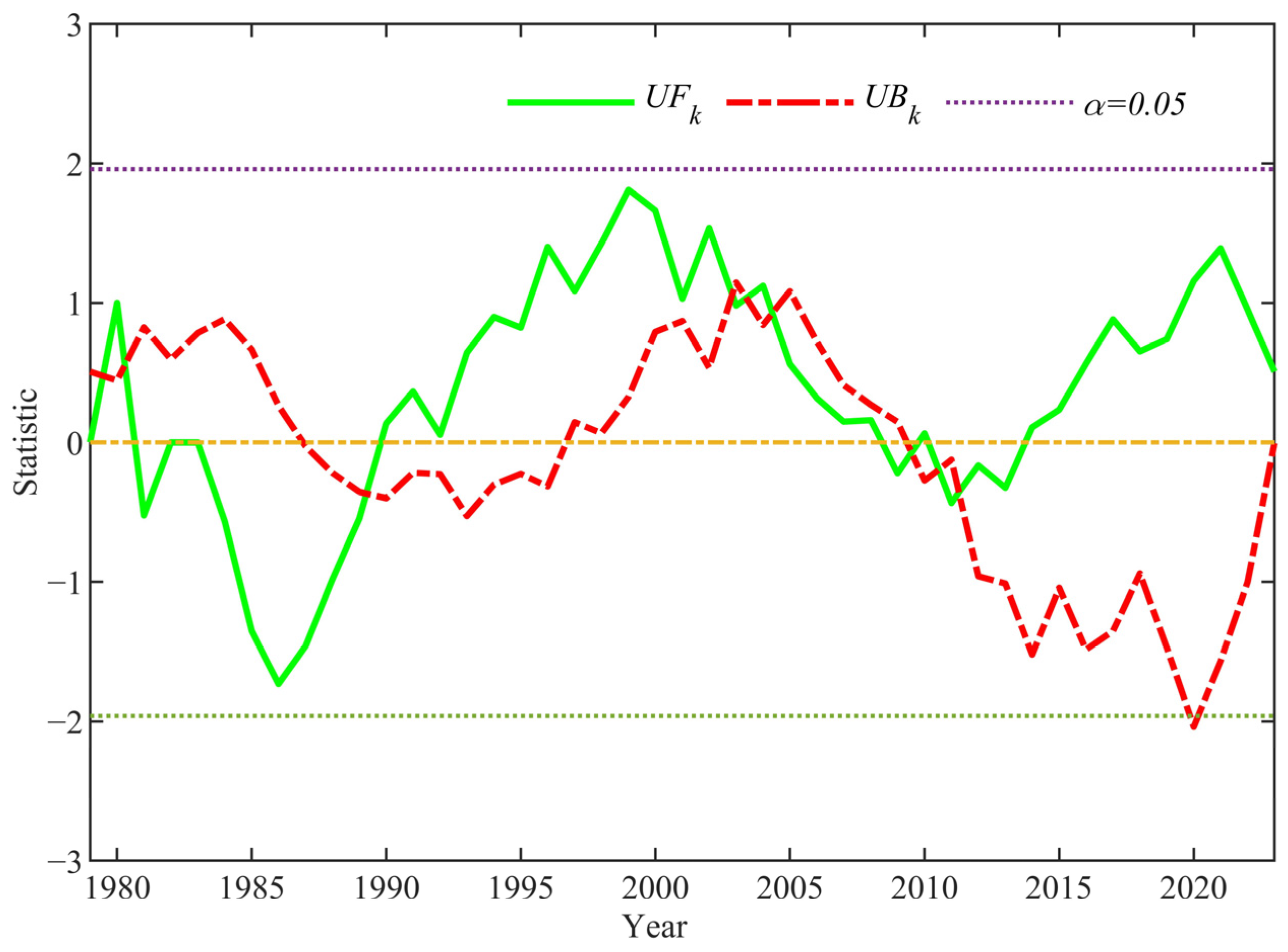

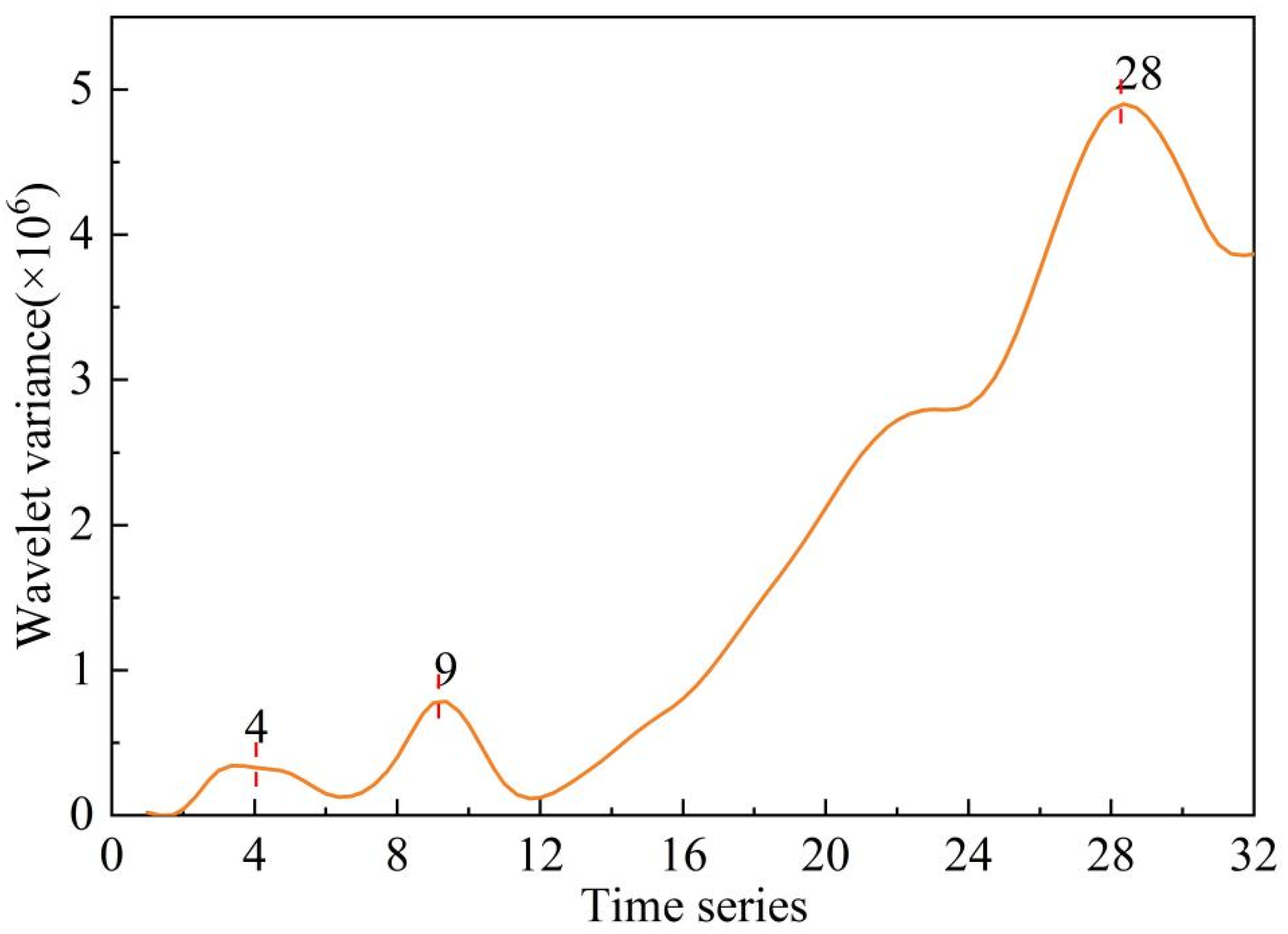
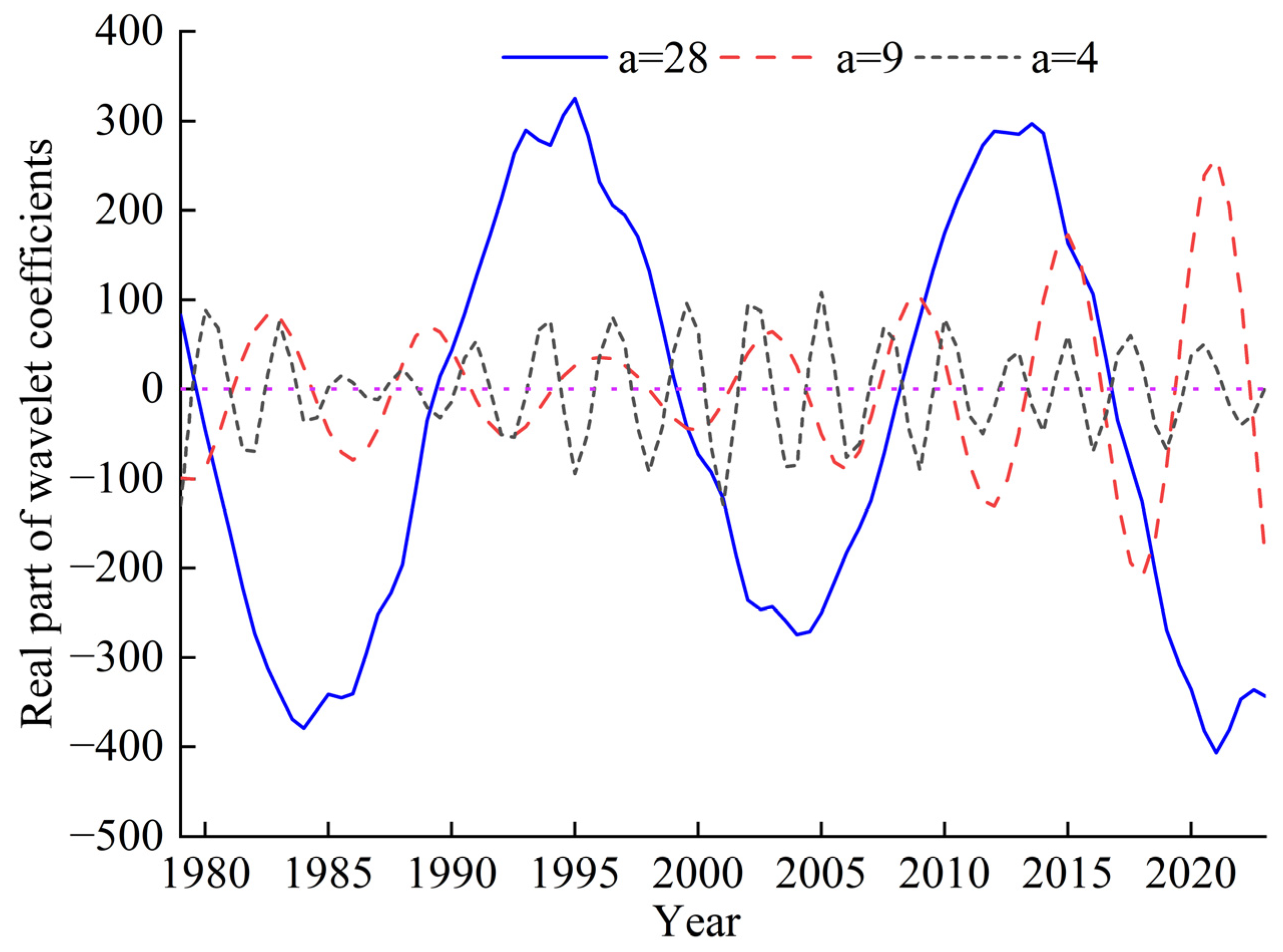

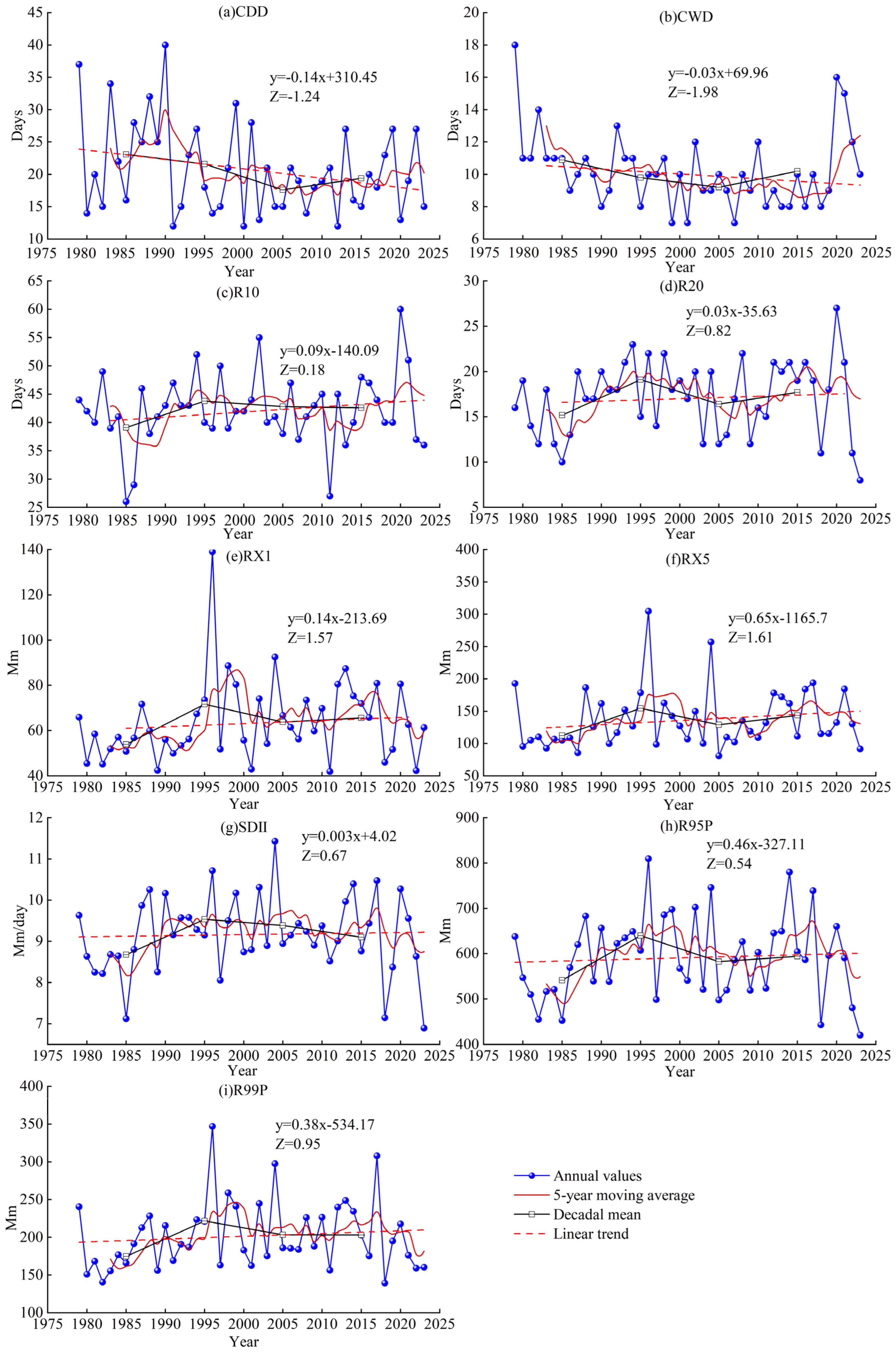


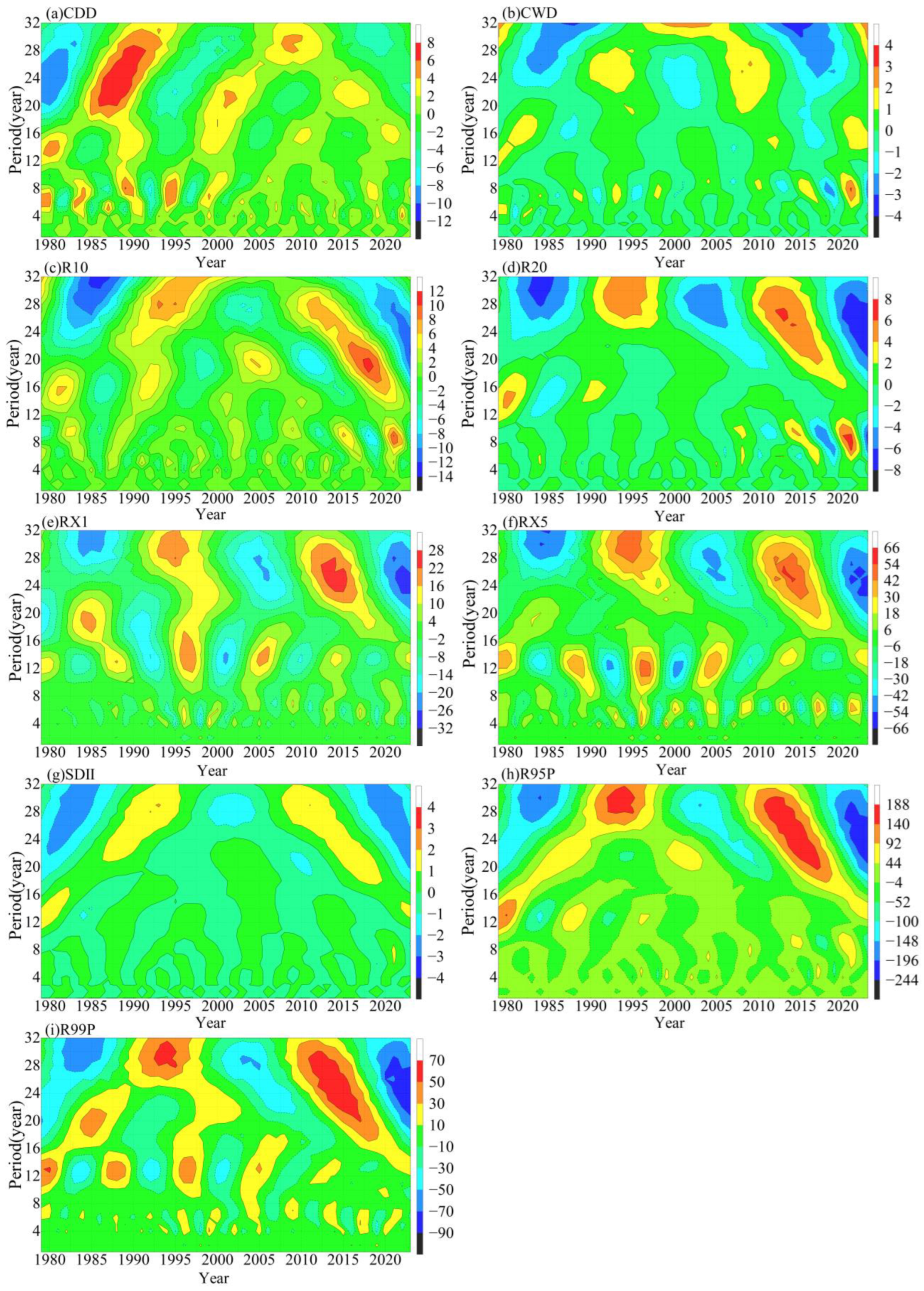
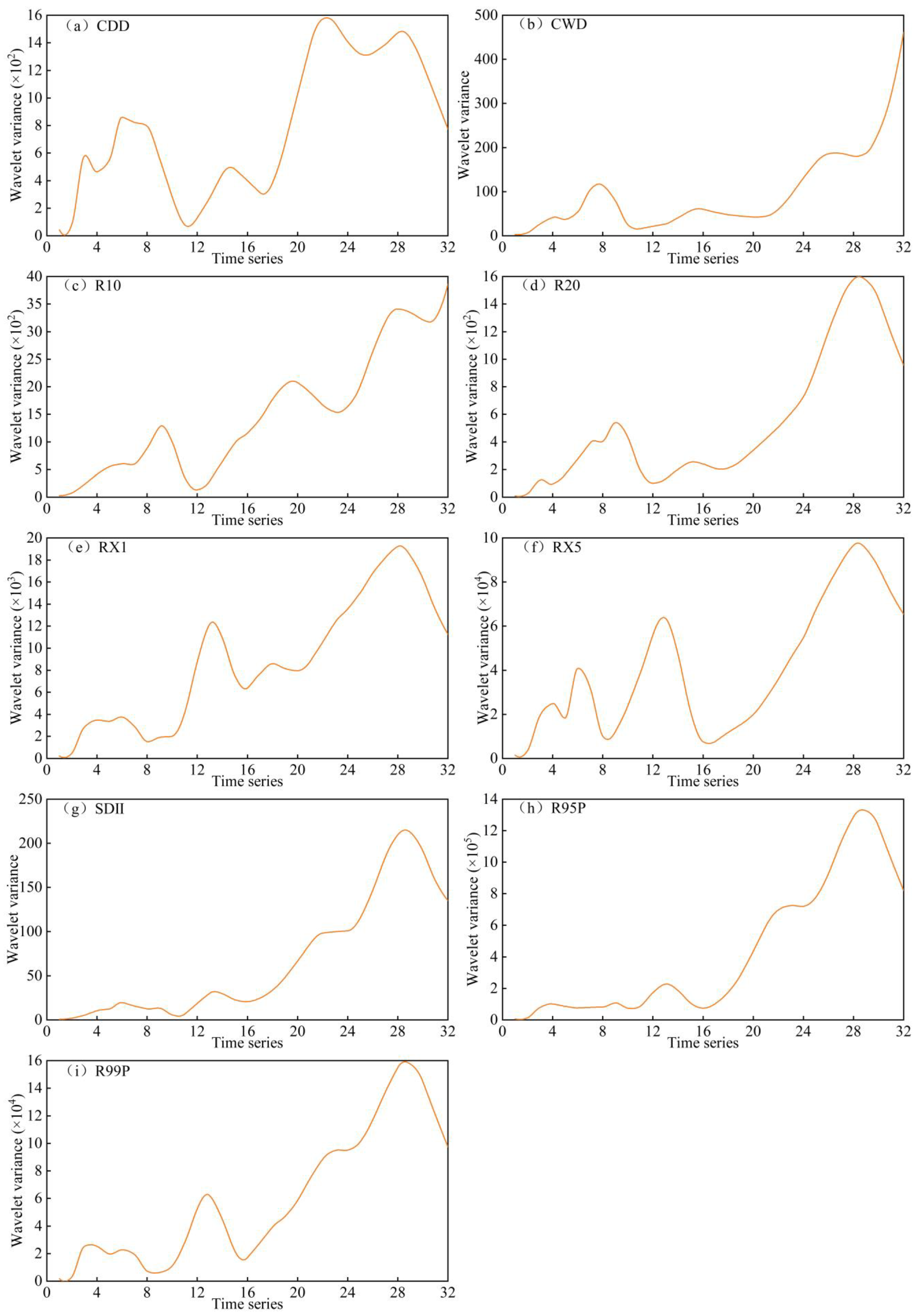

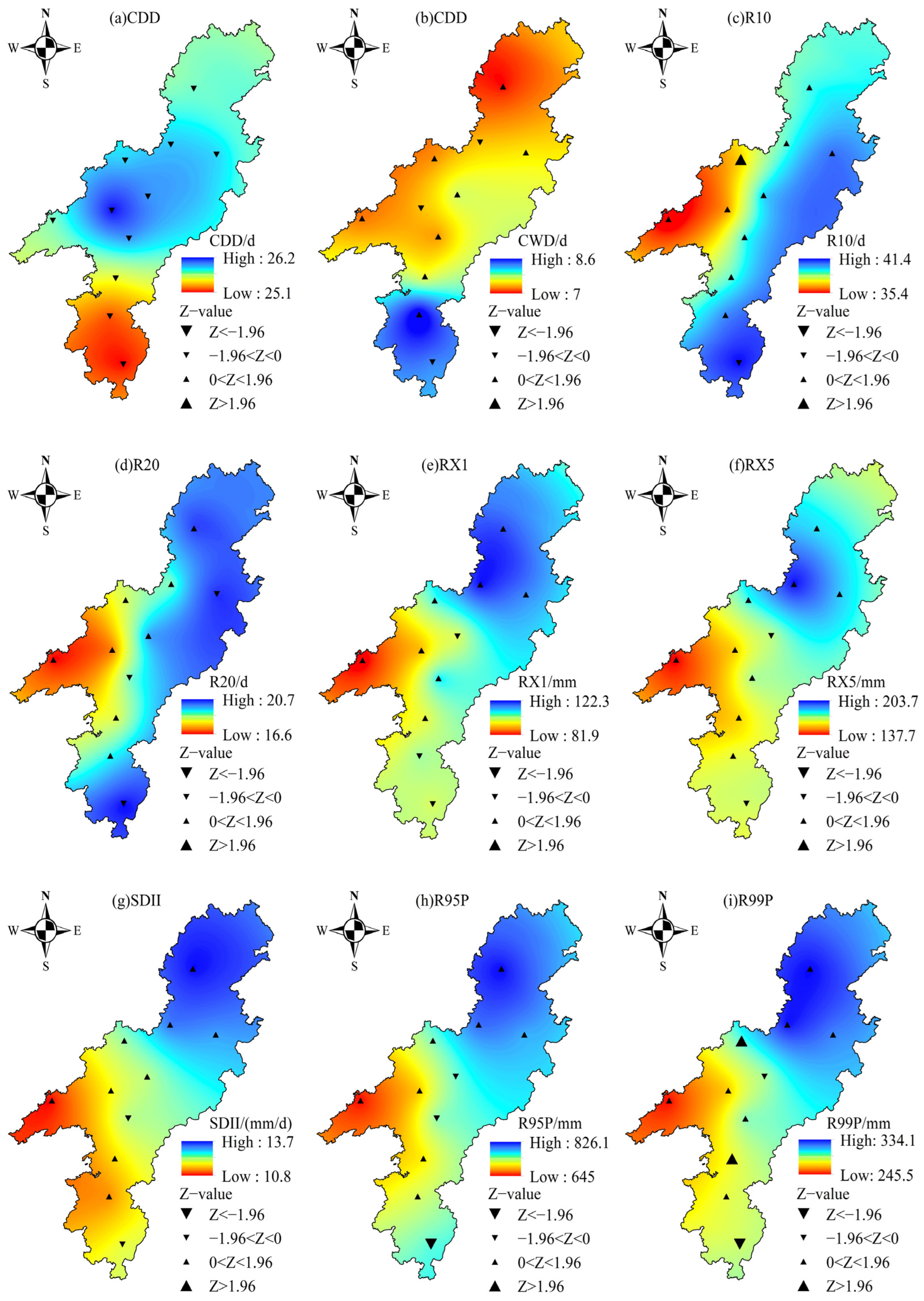
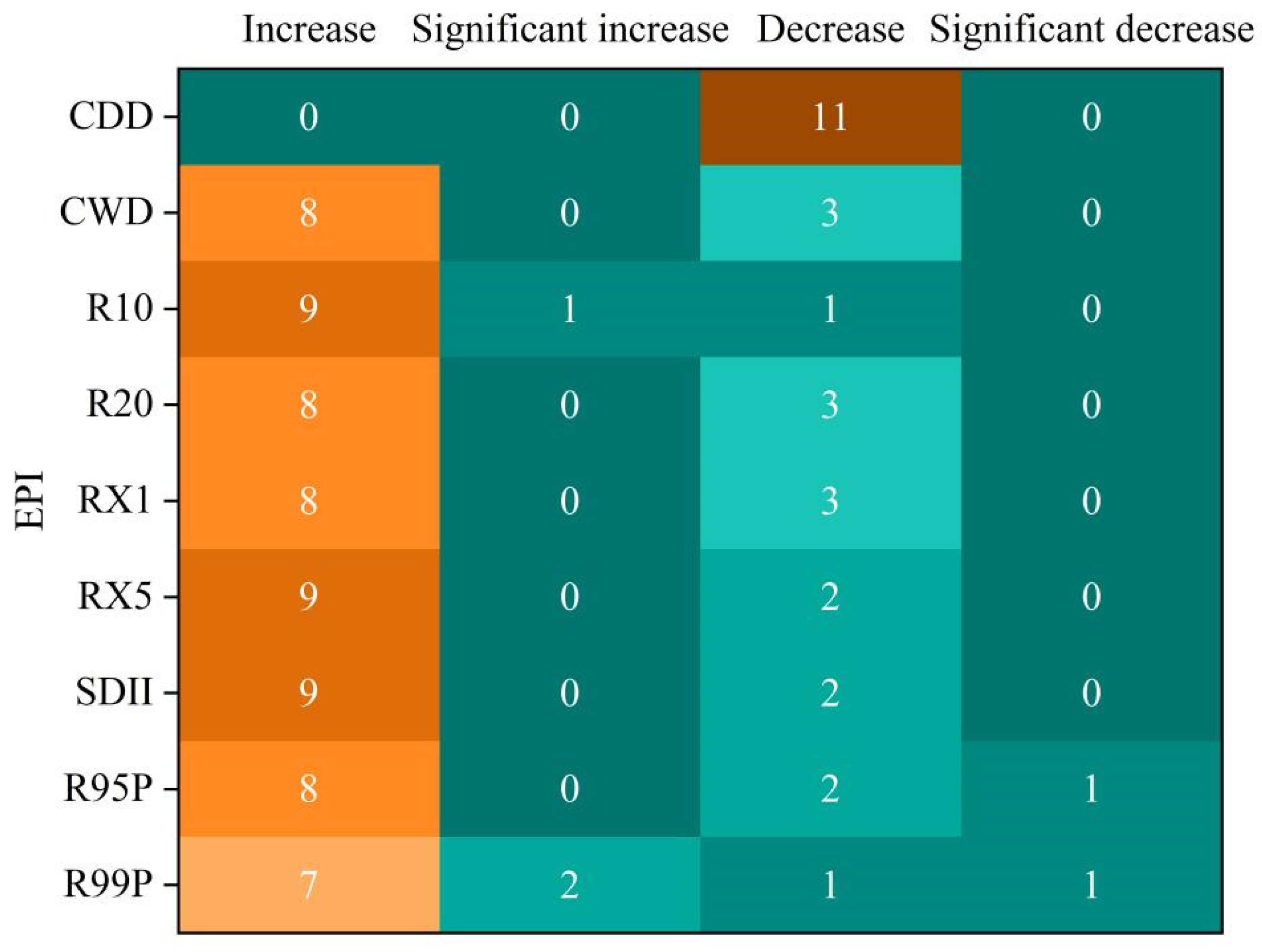
| Index | Indicator Name | Definitions | Units |
|---|---|---|---|
| CDD | Consecutive dry days | Maximum number of consecutive days with daily precipitation < 1 mm in a year | days |
| CWD | Consecutive wet days | Number of consecutive days with daily precipitation ≥ 1 mm in a year | days |
| R10 | Number of heavy precipitation days | Annual count of days with daily precipitation ≥ 10 mm | days |
| R20 | Number of very heavy precipitation days | Annual count of days with daily precipitation ≥ 20 mm | days |
| RX1 | Max 1-day precipitation | Maximum 1 day precipitation amount in a year | mm |
| RX5 | Max 5-day precipitation | Maximum consecutive 5 day precipitation amount in a year | mm |
| SDII | Simple daily intensity index | Ratio of annual total precipitation to the number of wet days (daily precipitation ≥ 1 mm) | mm/days |
| R95P | Precipitation amount for very wet days | Total precipitation from days exceeding the 95th percentile threshold (calculated from long-term daily precipitation series) in a year | mm |
| R99P | Precipitation amount for extremely wet days | Total precipitation from days exceeding the 99th percentile threshold (calculated from long-term daily precipitation series) in a year | mm |
| Decade | 20th Century | 21st Century | ||
|---|---|---|---|---|
| 1980s | 1990s | 2000~2009 | 2010~2020 | |
| CDD | 23.1 | 21.6 | 17.6 | 19.4 |
| CWD | 10.9 | 9.8 | 9.2 | 10.2 |
| R10 | 39.1 | 43.8 | 42.8 | 42.6 |
| R20 | 15.2 | 19.1 | 16.4 | 17.7 |
| RX1 | 53.97 | 71.68 | 63.73 | 65.62 |
| RX5 | 112.21 | 154.67 | 128.88 | 143.74 |
| SDII | 8.67 | 9.53 | 9.38 | 9.06 |
| R95P | 541.26 | 640 | 582.61 | 594.31 |
| R99P | 174.67 | 221.68 | 203.24 | 202.87 |
| Index | CDD | CWD | R10 | R20 | RX1 | RX5 | SDII | R95P | R99P |
|---|---|---|---|---|---|---|---|---|---|
| Mutation years | 1990 | 1980 | 1990 2002 | 1988 | 1992 | 1989 | 1985 | 1985 | 1984 |
Disclaimer/Publisher’s Note: The statements, opinions and data contained in all publications are solely those of the individual author(s) and contributor(s) and not of MDPI and/or the editor(s). MDPI and/or the editor(s) disclaim responsibility for any injury to people or property resulting from any ideas, methods, instructions or products referred to in the content. |
© 2025 by the authors. Licensee MDPI, Basel, Switzerland. This article is an open access article distributed under the terms and conditions of the Creative Commons Attribution (CC BY) license (https://creativecommons.org/licenses/by/4.0/).
Share and Cite
Wu, J.; Zhong, L.; Liu, D.; Tan, X.; Pu, H.; Chen, B.; Li, C.; Zhang, H. Analysis of Precipitation Variation Characteristics in Typical Chinese Regions Within the Indian Ocean and Pacific Monsoon Convergence Zone. Water 2025, 17, 1812. https://doi.org/10.3390/w17121812
Wu J, Zhong L, Liu D, Tan X, Pu H, Chen B, Li C, Zhang H. Analysis of Precipitation Variation Characteristics in Typical Chinese Regions Within the Indian Ocean and Pacific Monsoon Convergence Zone. Water. 2025; 17(12):1812. https://doi.org/10.3390/w17121812
Chicago/Turabian StyleWu, Junjie, Liqun Zhong, Daichun Liu, Xuhua Tan, Hongzhen Pu, Bolin Chen, Chunyong Li, and Hongbo Zhang. 2025. "Analysis of Precipitation Variation Characteristics in Typical Chinese Regions Within the Indian Ocean and Pacific Monsoon Convergence Zone" Water 17, no. 12: 1812. https://doi.org/10.3390/w17121812
APA StyleWu, J., Zhong, L., Liu, D., Tan, X., Pu, H., Chen, B., Li, C., & Zhang, H. (2025). Analysis of Precipitation Variation Characteristics in Typical Chinese Regions Within the Indian Ocean and Pacific Monsoon Convergence Zone. Water, 17(12), 1812. https://doi.org/10.3390/w17121812





